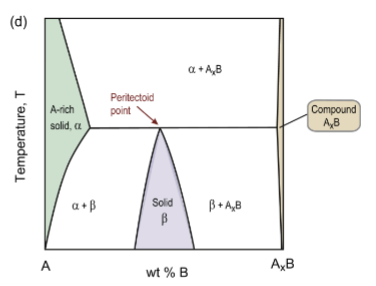Chapter 22 Materials
1/42
There's no tags or description
Looks like no tags are added yet.
Name | Mastery | Learn | Test | Matching | Spaced |
|---|
No study sessions yet.
43 Terms
phase diagrams and phase transformations
central to understanding microstructure, properties, and processing paths.
metallic alloy
a mixture of a metal with other metals or non-metals (often form precipitates/inclusions).
Components
the chemical elements that make up alloys.
binary alloy
contains two components.
Alloy compositions
defined by concentration in weight % or atom %.
phase
A region of a material that is structurally homogeneous (same crystal structure) and distinct (interface with surroundings)
Three forms of water (solid, liquid gas) are each one; water and alcohol have unlimited solubility (one); salt + water have limited solubility (excess salt means 2); oil and water have virtually no solubility (2)
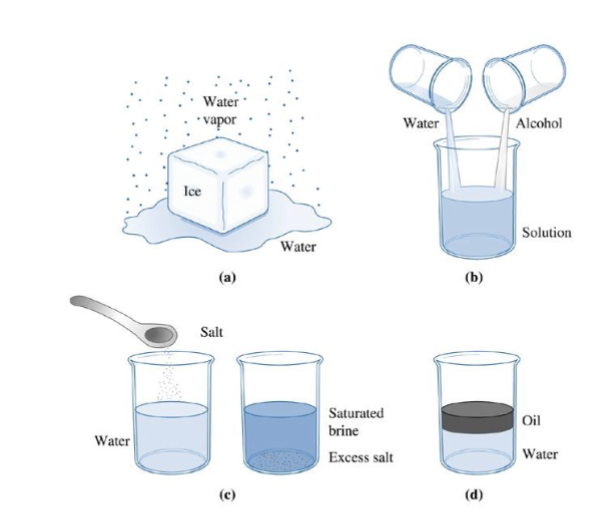
constitution of an alloy
described by:
• The identity of phases present. (at equilibrium)
• The composition of each phase.
•The fraction of each phase
these properties are represented in a phase diagram
stable
At thermodynamic equilibrium, the constitution is _______ (no change is possible).
equilibrium constitution
the state with the lowest Gibbs free energy for a given composition, temperature, and pressure; shown in phase diagram; minimizes energy state
phase diagram
a diagram with temperature and composition as axes, showing the equilibrium constitution. It is like a map and is divided into fields or regions.

one dimensional phase diagram
for a pure substance, a temperature scale showing the phase boundary between solid and liquid – the melting point
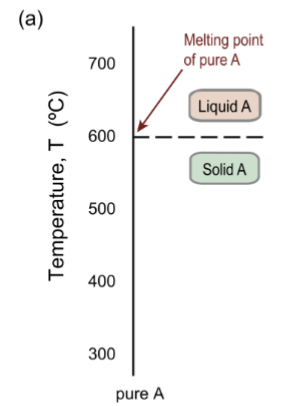
two elements in phase diagram
the A-rich end of a binary A–B phase diagram, illustrating partition of the melting point between solidus and liquidus boundaries
solid is always crystalline; S+L is the freezing range, and both solid and liquid are present
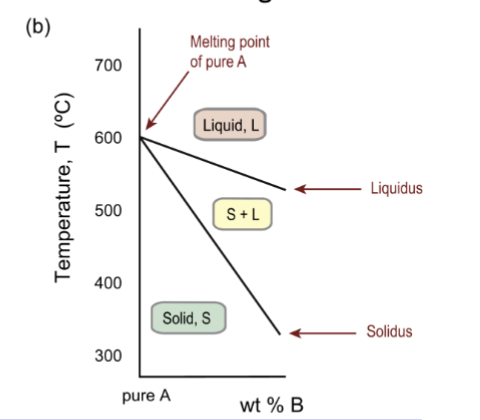
Isomorphous Phase Diagram
simplest type of phase diagram
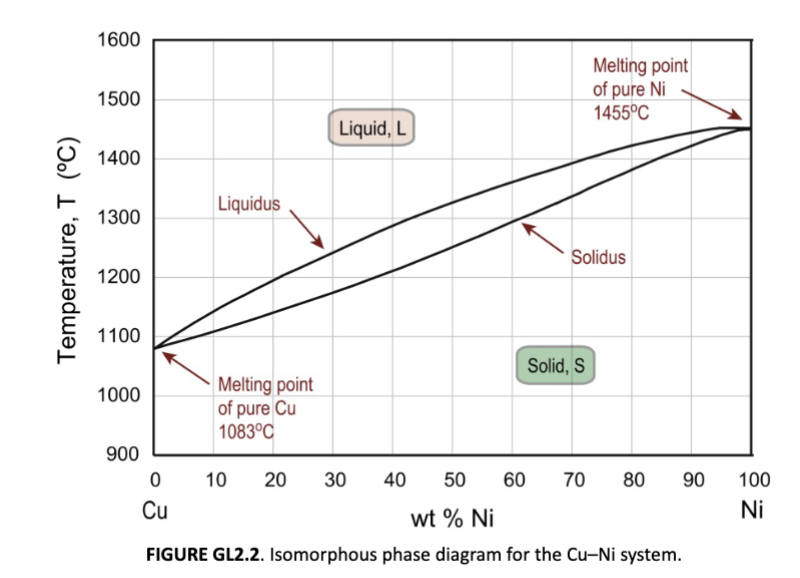
isomorphous
For two components, we have a binary phase diagram. If there is complete solubility in the solid phase, the system is said to be…
liquidus line
boundary between liquid and L+S two-phase field
Solidus line
boundary between solid and L+S two-phase field.
Freezing range
Difference between solidus and liquidus temperatures for a given composition.
tie line
For an alloy at coordinates T-X inside a two-phase region, a _______ at the temperature of interest fixes the compositions of the two phases.
Constant temperature → extend line to liquidus and solidus to get composition of liquid and solid
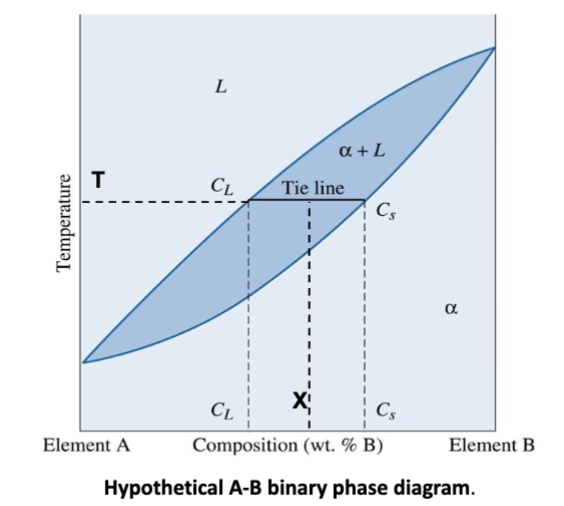
composition of phases in Cu-40% NI alloy at different temperatures
The vertical line represents overall composition of the alloy:
1300°C: Only liquid is present. The liquid must contain 40%Ni, the overall composition of the alloy.
1270°C: Two phases are present. The liquid contains 37%Ni, and the solid contains 50%Ni.
1250°C: Again, two phases are present. The tie-line drawn at this temperature shows that the liquid contains 32%Ni and the solid contains 45%Ni.
1200°C: Only solid is present, so the solid must contain 40%Ni
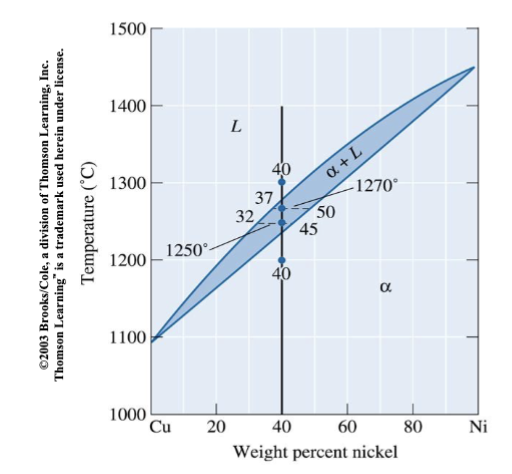
phase fraction
=(opposite arm of lever)/(total length of tie-line); part of the lever rule for proportion of phases
fraction α = (C-C1)/(C2-C1)
fraction L = (C2-C)/(C2-C1)
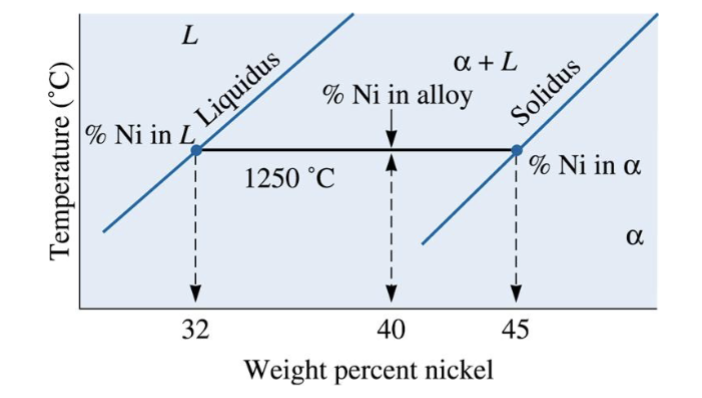
lever rule for two solids composition
fraction α = (b/l)
fraction β = (a/l)

solvus line
the boundary between the single- and two-phase regions; saturation level for solutions increases with temperature
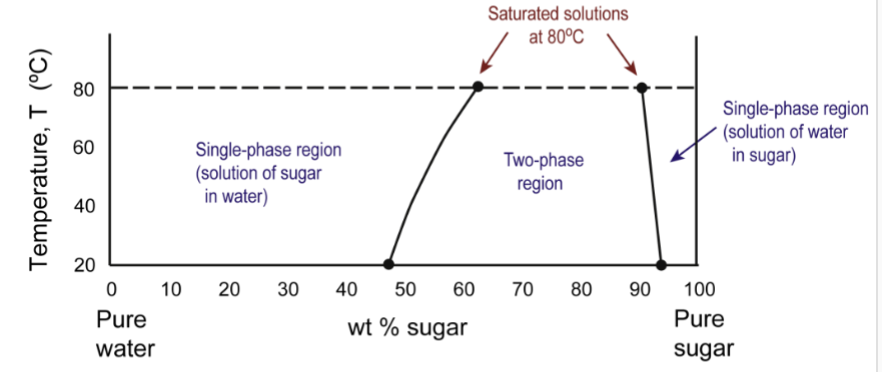
solubility
how much can we add of one material to another without producing an additional phase
unlimited solubility
soluble in all proportions; water and alcohol as liquid, Ni and Cu in both liquid and solid. In the solid (a solid solution), both Ni and Cu are FCC elements.
limited solubility
soluble up to a point where second phase begins to form (water and salt, Cu and Zn). Can also mean almost no solubility (oil and water, Cu and Pb)
Hume-Rothery Rules
necessary but not sufficient conditions for unlimited solid solubility:
size - within 15% difference in atomic radius
crystal structure - same for both elements
valence - same for both types of atoms
electronegativity - similar for both types of atoms
eutectic point
The lower limit of the single-phase liquid field formed by the two liquidus boundaries; example of an invariant point

eutectic reaction
at this point, this reaction occurs on cooling: Liquid → Pb-rich solid solution + Sn-rich solid solution (essentially two different solids upon cooling)
maximum solubilities
in the solid phases, usually occur at the same temperature
intermediate phases
many systems exhibit these. These compounds often have high melting points and are very stable. Ex: intermetallic compounds, where metal atoms are preferentially bonded to the other type of atom
Pretty strong and low ductility
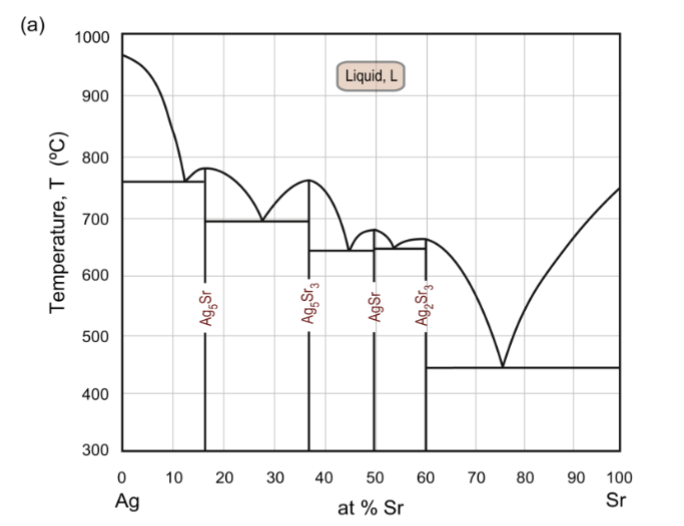
intermetallic compounds.
If the components are both metals with stoichiometric or near-stoichiometric compositions (in atomic percent), then we call them this.
intermediate phase diagram
each intermediate phase has its own eutectic point/reaction. Straight lines mean fixed stoichiometry. This one has four distinct intermediate phases/compounds
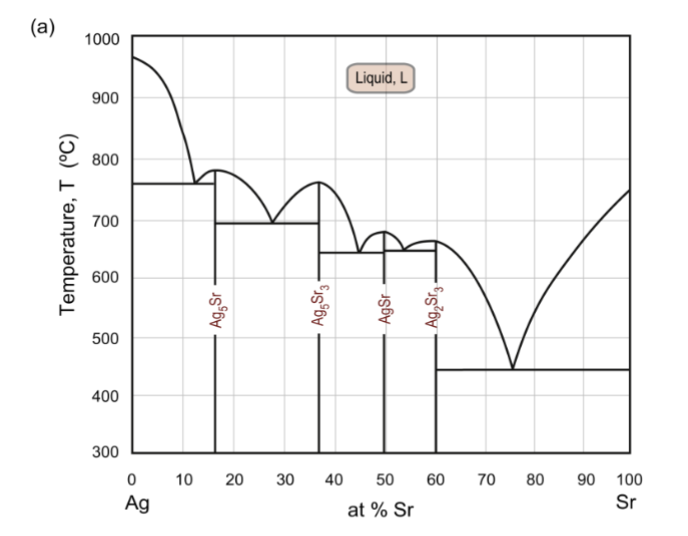
Fe-C compounds
encompasses cast irons (high wt% C) and steels (lower wt% C)
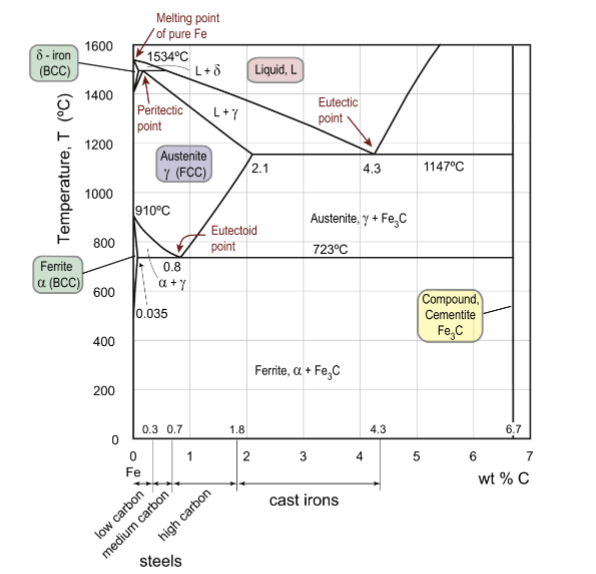
austenite
FCC iron phase, gamma; at elevated temperatures, there is a big solubility of carbon compared to BCC (wide range of properties)
up to 2.1wt% C in solid solution
ferrite
BCC iron phase, can be denoted alpha (low) or delta (high) based on temperature; unstable intermediate; same phase but just different temperatures
α: up to 0.03wt% C in solid solution
δ: up to 0.08wt% C in solid solution
cementite
Fe3C, iron carbide; about 25% atomic carbon; up to 6.7wt% C
eutectoid point for Fe-C
the lower limit of a single-phase solid field formed by two falling phase boundaries intersecting in a ‘V’. Reaction is γ → α + Fe3C.
peritectic point for Fe-C
reaction is L + δ → γ upon cooling
four basic types of reactions
eutectic, eutectoid, peritectic, and peritectoid
eutectic reaction
liquid → two different solids upon cooling
L → α + β
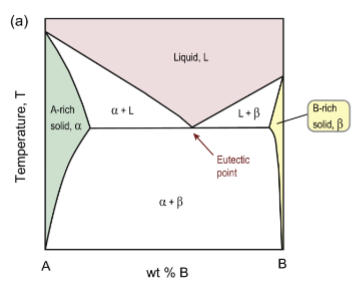
eutectoid reaction
solid → two other, different solids upon cooling
γ → α + AxB
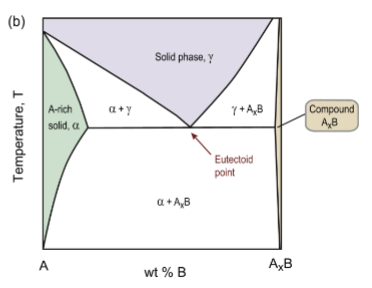
peritectic reaction
solid + liquid → other solid upon cooling (2 phases to get 1 phase)
α + L → δ

peritectoid reaction
solid + solid → other solid upon cooling
α + AxB → β
